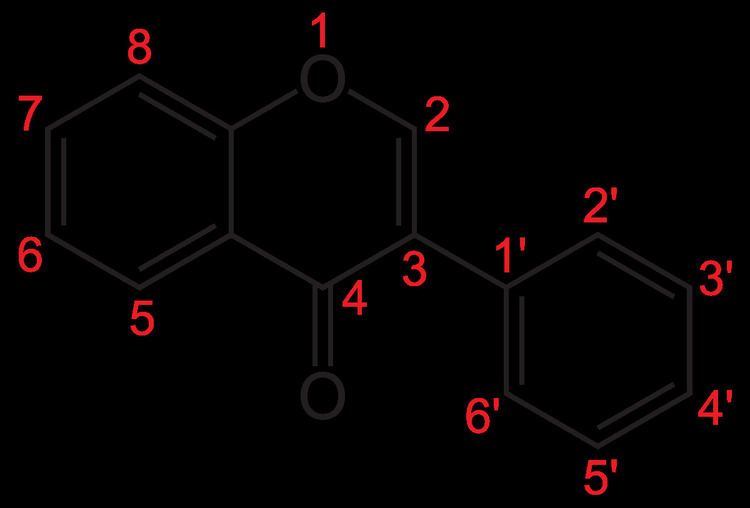 | ||
Isoflavones are a type of naturally occurring isoflavonoids, many of which act as phytoestrogens in mammals. Isoflavones are produced almost exclusively by the members of the Fabaceae (i.e., Leguminosae, or bean) family.
Contents
Although isoflavones and closely related phytoestrogens are sold as dietary supplements, there is little scientific evidence for either the safety of long-term supplementation or of health benefits from these compounds. Some studies have identified potential risks from high intake of isoflavones, such as in women with a history of breast cancer, but this concern has not been substantiated with high-quality clinical research.
Organic chemistry and biosynthesis
Isoflavones of nutritional interest are substituted derivatives of isoflavone, being related to the parent by the replacement of two or three hydrogen atoms with hydroxyl groups. The parent isoflavone is of no nutritional interest.
Isoflavone differs from flavone (2-phenyl-4H-1-benzopyr-4-one) in location of the phenyl group.
Isoflavones are produced via a branch of the general phenylpropanoid pathway that produces flavonoid compounds in higher plants. Soybeans are the most common source of isoflavones in human food; the major isoflavones in soybean are genistein and daidzein. The phenylpropanoid pathway begins from the amino acid phenylalanine, and an intermediate of the pathway, naringenin, is sequentially converted into the isoflavone genistein by two legume-specific enzymes, isoflavone synthase, and a dehydratase. Similarly, another intermediate naringenin chalcone is converted to the isoflavone daidzein by sequential action of three legume-specific enzymes: chalcone reductase, type II chalcone isomerase, and isoflavone synthase. Plants use isoflavones and their derivatives as phytoalexin compounds to ward off disease-causing pathogenic fungi and other microbes. In addition, soybean uses isoflavones to stimulate soil-microbe rhizobium to form nitrogen-fixing root nodules.
Occurrence
Most members of the Fabaceae family contain significant quantities of isoflavones. Analysis of levels in various species has found that the highest levels of genistein and daidzein in psoralea (Psoralea corylifolia). Various legumes including soybean (Glycine max L.), green bean (Phaseolus vulgaris L.), alfalfa sprout (Medicago sativa L.), mung bean sprout (Vigna radiata L.), cowpea (Vigna unguiculata L.), kudzu root (Pueraria lobata L.), and red clover blossom and red clover sprout (Trifolium pratense L.) have been studied for their estrogenic activity. Highly processed foods made from legumes, such as tofu, retain most of their isoflavone content, and fermented miso, which has increased levels.
Other dietary sources of isoflavones include chick pea (biochanin A), alfalfa (formononetin), and peanut (genistein). Isoflavones are also found in foods of animal origin such as dairy products, meat, eggs and seafood, but the overall contribution to total intake is low. In countries using the chorleywood bread process, such as in the UK, bread is a source of isoflavones from soy.
In plant tissue, they most often occur as glycosides or their respective malonates or acetyl conjugates, rendering them even more water-soluble (see isoflavone-7-O-beta-glucoside 6"-O-malonyltransferase). The latter forms are unstable and are transformed, e.g. by decarboxylation. Often when leguminose plants are challenged with viral or fungal infections, the water-soluble transport forms are hydrolyzed to the respective aglycones at the target site.
Research
The consumption of isoflavones-rich food or dietary supplements is under preliminary research for its potential association with lower rates of postmenopausal cancer and osteoporosis in women. Use of soy isoflavone dietary supplements may be associated with reduction of hot flashes in postmenopausal women.
Despite the frequent use of isoflavone supplements, there are insufficient data on safety and adverse effects. Isoflavones have GRAS status in the United States. The European Food Safety Authority has conducted a risk assessment of isoflavone supplements for post-menopausal women and could not identify adverse effects with intakes up to 150 mg/d, although it criticised the lack of data.
